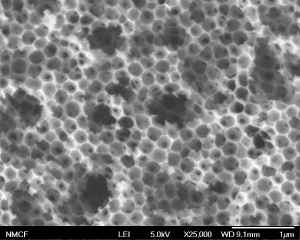Aug 6 2008
Fuel cells are one of the most touted new energy technologies. They directly convert the chemical energy of fuels into electrical energy, doing so roughly twice as efficiently as a diesel engine.
 This nano-scale honeycomb structure enables more efficient chemical reactions in a new generation of fuel cells
This nano-scale honeycomb structure enables more efficient chemical reactions in a new generation of fuel cells
The biggest stumbling block preventing the widespread adoption of fuel cell technology has been a reliance on hydrogen as the "fuel." Not only is hydrogen both difficult and dangerous to store and distribute, but 96 percent of hydrogen comes from oil and gas. Fuel cells that rely on hydrogen do little to reduce fossil fuel use.
New research from a University of Virginia team, recently funded by a new U.Va. Collaborative Sustainable Energy Seed Grant worth about $30,000, is taking two approaches to removing the need for hydrogen.
The twin projects will both use similar nano-scale engineering in very different applications, explained team member Steve McIntosh, an assistant professor of chemical engineering. One half of the project will apply new nano-scale structures to try and create a new type of "solar cell" that will gather the energy of sunlight to electrochemically split water into its molecular components of oxygen and hydrogen, which could potentially provide a practically limitless, renewable source of hydrogen.
The other half of the research will use similar nano-scale structures to bypass hydrogen and create a new type of fuel cell that can transform renewable biofuels like biodiesel directly into electricity.
"There's not going to be a silver bullet to solve the problem, so we've got to pursue multiple approaches," McIntosh said.
The nano-scale surface structures being developed are hundreds of times smaller and more precise than existing technology, which offers several expected advantages, McIntosh said. For instance, nano-scale surface structures will make the ion reactions much quicker and more efficient. "It's very important to control the issues down at that scale where everything is happening," McIntosh noted.
More efficient chemical reactions may allow these new fuel cells – known as direct-hydrocarbon solid oxide fuel cells – to operate at much lower temperatures (500 degrees Celsius instead of 800), making them more stable and longer-lasting, McIntosh said.
The goal is a fuel cell that can produce 10,000 hours of electricity to be used in a new type of small power plant, which would provide enough power for a small town or even a city block. A distributed power grid based on such plants would be more efficient than our current power grid.
Even though nano-technology seems to have great potential to improve these types of solar and fuel cells, so far only one paper on this topic has been published, said McIntosh, who last year won a $400,000 National Science Foundation (NSF) Faculty Early Career Development grant for his pioneering work on fuel cells.
His U.Va. collaborators on the current research project are Despina Louca, an associate professor of physics, and Giovanni Zangari, an associate professor of materials science and engineering. Zangari is an expert on the "solar cell" half of the project. Louca will use neutron diffraction equipment at the Oak Ridge National Laboratory in Tennessee to measure how the nanoscale structures work over time.
Any improvements in fuel cell technology are highly sought after and should quickly attract further research dollars from agencies like the U.S. Department of Energy, or the Defense Advanced Research Projects Agency (DARPA), which has put out a request for a portable power generator that uses fuel cells running directly on diesel fuel, McIntosh said.
In the meantime, he said, this seed grant "gets people motivated and gets them going."